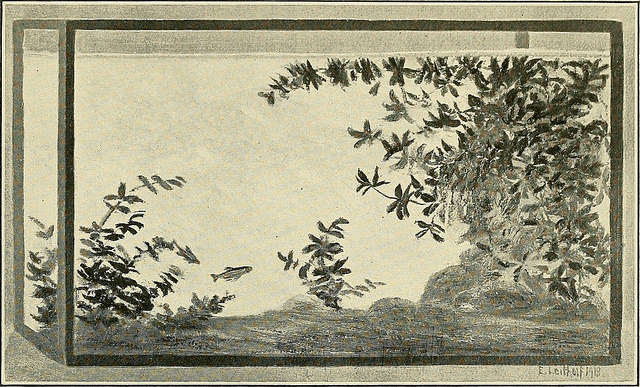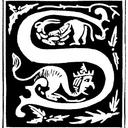Thoughts on the Love Domain Cleric
As I looked through a bunch of the discussion around the Love Domain cleric, it became clear that the criticism of some of the powers removing consent wasn't clear, especially concerning the criticism made that it could be referred to as the "'roofie' domain."
I appreciate that discussion was fast and often furious and folks might not want to discuss the details anymore. Having a full-time job and a three-year-old makes it hard to participate in the conversation in a more timely manner, but I'd like to give the conversation a try.
First, I want to say it's clear that through some of the design that thought was put in, especially in the area of the bonds. My gut tells me some portion of the folks involved in the design were going for an Aphrodite/Eros/Cupid vibe and particularly their tendency to use mind control and those folks either weren't aware or chose to ignore the problematic aspects to those stories.
I don't say that to shame or otherwise assign blame. Just that we live in a culture that tends to minimize the importance of consent and sometimes make excuses for stories that involve in removing the ability to willingly and enthusiastically consent.
Second, while it's important at some point to discuss the role of consent when it comes to sex (especially with regards to a Love Domain), for the purposes of this discussion, I'm going to keep the conversation more centered on the idea of what it means to remove consent and how some types of drugs make that easier. I won't talk about instances of sexual assault or rape but will use the story of someone who was drugged but didn't have anything additionally negative happen to them.
With all that said, let's dig in, shall we?
Understanding Roofies
One of the first things that stood out to me reflecting on the response is that a lot of folks don't understand the group of drugs called "date rape drugs" or "roofies." For instance, I recently had a conversation with someone under the impression that roofies knocked the victim out, rendering them unconscious. That was because the expected usage is to help people unable to fall asleep do so.
However, when these drugs are used in an off-label way (often on unknowing or unwilling participants), it's the combination of the following reactions that the administrators of the drug are looking for: reduce inhibitions, sedate folks, and cause memory loss. It's also important to note here that while "roofies" are often used to facilitate sexual assault and rape (along with other substances such as alcohol), there have actually been many cases of people just adding these substances to people's drink for what they consider to be fun.
Because people are sometimes unwittingly drugged by an unconnected third party, we have situations where reliable third parties are present during the episode. For instance, I found this description in an article by Jordan Kisner, describing what happened when she was drugged while at a bar with her then-boyfriend, John.
Twelve hours after being drugged, I woke up shaking in John’s bed, fully clothed, and on top of the covers. My knowledge of the interim is pieced together mostly from what he told me. Apparently, I’d grown radiantly happy and then quickly, dramatically incapacitated. I’d stopped talking, and then walking. I ran into walls. He took me back to his apartment to put me to bed, but I managed to lock myself in his bathroom for 30 minutes and either wouldn’t or couldn’t respond to his attempts to coax me out. When I finally emerged, he suggested I sit down, and I sat. He told me I should drink water, and I wordlessly accepted the cup. This was what unnerved him the most in the retelling: how pliable I had been. “You would do things, but you weren’t there,” he said.
https://www.thecut.com/2014/10/what-you-might-not-know-about-getting-roo...
What we can get from this description is that for at least some folks, the response is not to turn into an unconscious log but rather someone who clearly has an altered mental state and may become more "pliable" or compliant. It's important to keep that in mind as we look at the components of the domain.
Comparison to Charm Person
Now let's quickly look at Charm Person and Charmed.
Charm Person
You attempt to charm a humanoid you can see within range. It must make a Wisdom saving throw, and does so with advantage if you or your companions are fighting it. If it fails the saving throw, it is charmed by you until the spell ends or until you or your companions do anything harmful to it. The charmed creature regards you as a friendly acquaintance. When the spell ends, the creature knows it was charmed by you.
Charmed
A charmed creature can’t Attack the charmer or target the charmer with harmful Abilities or magical Effects.
The charmer has advantage on any ability check to interact socially with the creature.
Right away I see a few things here that line up with the criticism. Charm person can take someone who is hostile to you and make them a friendly acquaintance. It doesn't say it here, but I think it's common knowledge that the reason why this spell exists and used is to make the target more agreeable to the person. This could be relatively benign, for instance a character could use it to counter someone who is under a different mind control spell. Or it could be more malicious, make someone more likely to do something that is in the caster's favor at the expense of the person who would have benefited from the target's free will.
Most importantly, this sort of modification, typically for the benefit of the administrator of the substance, of a person's mental state is the purpose of these drugs. And yes, there are additional protections here that don't apply in real life, the caster and their companions can't do anything that the DM would rule as harm to the target and amnesia isn't part of the spell. But I hope that folks can at least see where this criticism is still valid. The intent of both is to alter someone's mental state and make them more likely to do things they wouldn't otherwise do.
Comparison of Hypnotic Pattern, Confusion, and Hold Monster
Hypnotic pattern
You create a twisting pattern of colors that weaves through the air inside a 30-foot cube within range. The pattern appears for a moment and vanishes. Each creature in the area who sees the pattern must make a Wisdom saving throw. On a failed save, the creature becomes charmed for the duration. While charmed by this spell, the creature is incapacitated and has a speed of 0.
The spell ends for an affected creature if it takes any damage or if someone else uses an action to shake the creature out of its stupor.
I hope by now, this is an easy one to see the comparisons. As with charm person, the creature becomes charmed, making the target more pliable. And now, we've added incapacitation which can be an outcome of many of the date rape drugs.
Confusion
This spell assaults and twists creatures' minds, spawning delusions and provoking uncontrolled action. Each creature in a 10-foot-radius sphere centered on a point you choose within range must succeed on a Wisdom saving throw when you cast this spell or be affected by it.
More mind control, this one honestly feels eerily similar to what happens with some abusers.
Hold monster
Choose a creature that you can see within range. The target must succeed on a Wisdom saving throw or be paralyzed for the duration. This spell has no effect on undead. At the end of each of its turns, the target can make another Wisdom saving throw. On a success, the spell ends on the target.
Another incapacitation outcome.
Comparison to Channel Divinity: Impulsive Infatuation
You can use your Channel Divinity to overwhelm a creature with a flash of short-lived but intense admiration for you, driving them to rash action in your defense. As an action, you present your holy symbol and choose one creature you can see within 30 feet of you. That creature must make a Wisdom saving throw; a creature can choose to fail this saving throw if it wishes. On a success, the creature is unaffected. On a failure, the creature is charmed by you until the start of your next turn, and it must immediately use its reaction to make a weapon attack against a target you designate. If there are no valid targets, it uses its reaction to admire you.
Here again, we are overriding a creature's free-will and consent in hopes of influencing the outcome of an event and making that part of a "love domain." It's a bit harder here because the issues are only implicit in the text. By and large, the reason this class feature exists is to force a creature to do something it would not do such as attack one of its allies or something in the environment that would be helpful to hostile enemies.
Not only do the same critiques of charm person apply, but not only are we engaging in removing consent, it's a domain feature. Unlike charm person, which is just part of the game (not saying there aren't issues there, just the issues get highly magnified when packaging with the Love domain), this domain feature should, in part, be key to telling us what this domain is about. This should be iconoclastic. And what we end up getting is tightly tying the domain to removing consent.
Thoughts
Do I think this is easy to forget when designing something? Abso-f*ing-lutely. Especially when combined with all of the other criticism of the game, right? I mean, the bond powers are nice, but a lot of folks have been upset when clerics don't get enough damage dealing powers, right? And we definitely want to be careful of that with the love domain because it often gets thought of as feminine, right? Add into that a healthy serving of stories where this makes sense (looking at you Aphrodite/Eros/Cupid) and I totally get how someone gets to this place in writing.
But moving from there to publishing is super hard. We know the time we live in. Where we're still in the position of having to say "Cosplay is not consent" and even trying to get the public at large to live by the fact that consent can be withdrawn at any time. We live in a time of #MeToo. To put this as a domain feature of the love domain is, well, it's hard to process and feels, from the outside, like a failure somewhere in the chain.
More Like This Please: One Child's Heart
Currently on Kickstarter is a game called One Child's Heart, designed by Camdon Wright.
There are pivotal moments in every child’s life that shape who they become. One Child's Heart is a tabletop roleplaying game that invites players to take the role of child welfare professionals participating in a new mental health care memory exploration experiment. The Central Limbic Engagement Recovery System (CLERS – pronounced, “clears”) brings characters into the memories of these key moments to give support and guidance to a child who needs both.
What I love about this game is that it focuses on human connection and empathy while not being about "tragedy tourism." In addition, as hard as at may be to accept, players cannot change what has already happened. There is no ability to be the savior. But, just like in real life, what can be done is helping the child learn tools to cope with their life to come.
The basics of game play are described in the Kickstarter. Players take on one of five playable professions: the child psychologist, the clergy, law enforcement, the social worker, and the therapist. They help the child through the memory and attempt to earn enough tokens for an optimal outcome. Dice are used to determine whether or not a connection is made, which makes sense because each child is unique and the reality is that we cannot know what is going to connect with an individual.
In addition to the game idea itself, the reason why this is a "More Like This Please" post is because it has a kickass team working on it. First, let me be clear and say a number of people I know and admire are part of this, including Sharang Biswas whom I know from outside of gaming. The whole group is immensely talented and bring a diverse range of experiences to the table, incredibly important in a game such as this.
If you are interested in learning more, I recommend listening to the actual play sessions listed on the Kickstarter page:
Example of Including Pronouns: Uncaged Anthology Volume I!
A couple of weeks ago I posted a blog post discussing how including pronouns for characters could be helpful in a number of ways. Soon after I did a highlights flip through of a PDF and saw an example of including pronouns. The product? Uncaged Anthology: Volume 1*, a collection of adventures, each of which feature a creature that is traditionally considered female. Many of these adventures have a section called Dramatis Personae and within this section, some authors decided to include the character's pronouns.
As an example, here is the list from one of the adventures, The Guardian of the Forest, by Awkward Bard:
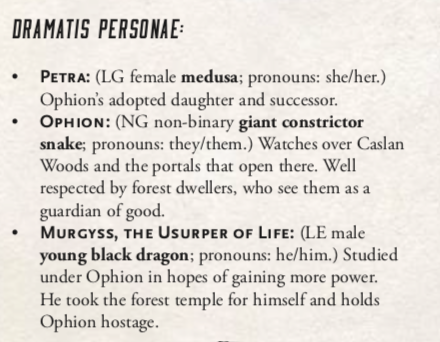
• Petra: (LG female medusa; pronouns: she/her.) Ophion’s adopted daughter and successor.
• Ophion: (NG non-binary giant constrictor snake; pronouns: they/them.) Watches over Caslan Woods and the portals that open there. Well respected by forest dwellers, who see them as a guardian of good.
• Murgyss, the Usurper of Life: (LE male young black dragon; pronouns: he/him.) Studied under Ophion in hopes of gaining more power. He took the forest temple for himself and holds Ophion hostage.
It was awesome to see that some folks are trying this out and this is an example others can use in their adventures.
If you are interested to learn more about Uncaged Anthology, the project's website can be found here. In April they are partnering with Non-Toxic Gaming to run a charity stream to raise money for RAINN.
I also did a selected flip through of the pdf and posted it on YouTube.
* Affiliate link
More Like This Please: Swordsfall and Welcome to Tikor
Swordsfall is an Afropunk Sci-Fantasy setting and future tabletop roleplaying game. It's a world where gods and spirits are real, where mortals can kill a god and the aftermath has world changing consequences.
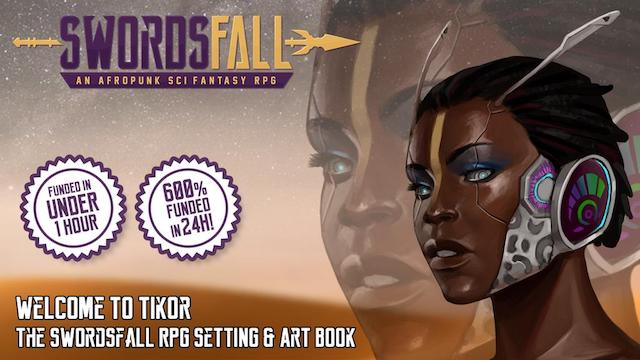
The action takes place on the world of Tikor, which is heavily influenced by and pulled from the rich and diverse pre-colonial history of Africa. For those who would love to learn more about the world, there are pages upon pages of content on WorldAnvil discussing and detailing it, sometimes in the form of knowledge articles and other times through fiction. The world comes alive through the words and artwork. Currently, there are more than 100 posts and the creation of the lore is supported through the Swordsfall Patreon.
If you are interested in learning more and especially if, like me, you might need a bit more of a clear introduction to the world (it's not easy to read websites with a toddler about), you might be interested in the Welcome to Tikor Kickstarter. The project aims to provide a setting and art book about the world, get a bunch of amazing art produced for this project and future use in the role playing game, and be a springboard for exploration into the world.
Since the project is already at almost $28k, backers will likely get at least 3 pdfs: the setting and art book, a book detailing the 34 professions, the pantheon, and a comic about the pirate Nubia. The lore is from Brandon Dixon. In addition, there will be art from T'umo Mere and Sabina Lewis, and pins from Taylor Ruddle. If additional goals are met, we'll also get art from Jonah Lobe and an additional book, this time on the creatures of Tikor.
For me, this project is important not only because representation matters, but also to undo some of the harm done by colonialism. We need to see this art and explore this lore. With so many ways to support this project (the Kickstarter, the Patreon, and by reading and sharing content from World Anvil), perhaps we can bring more light to the world. I love what I have read and seen thus far, and can't wait to see more.
The Autopsy Scene (Captain Marvel Spoilers)
Just to be clear, I'll be talking about some spoilers for the Captain Marvel movie as well as topics of dehumanization and the overemphasis on genitals.

This past Sunday, I was fortunate enough to go and see Captain Marvel in the theater. I think it's the first movie I've been able to see opening weekend since my child was born. And there was a lot that I loved about the movie.
I had tried to keep reading about spoilers to a minimum before seeing it, but there was one scene I knew was present in the movie. Because the person didn't want to get too specific about it, I knew that someone at some point "peeked" at someone's genitals. That general information and an understanding of how upsetting that can be to some, especially given the history of treatment of trans folks, was about all I knew going in.
For those who haven't seen the movie, and yes, let me remind again, spoiler alert, some folks learn for the first time about the existence of extraterrestrials, notably Fury. He learns this after a Skrull who had been impersonating his partner is killed and reverts form. We see him and his boss in the autopsy room discussing this new information and Fury at one point lifts the sheet to not only look at the alien's genital area (or at least assumed to be the genital area) but to share with his boss the looking at that area.
Most people have reported that at this point the audience laughs.
Ouch.
Part of the issue is that for many trans folks, this is pretty much a nightmare. People's emphasis and curiosity about "plumbing" cause many, many issues. And hearing people laugh at this makes it hurt even more. I want to say that the upset and pain experienced from that scene is valid and real.
I also want to talk about something I saw that I haven't heard discussed (although I admit to not looking too hard to see if anyone had.) I bring it up because I think it underscores how "dehumanizing" the lifting of the cover was. (Yes, I'm also at a loss for the correct terms to use for this since technically the Skrull aren't humans.)
At the moment Fury lifts the cover, we do not yet know that his boss is actually a Skrull in disguise. When we react to that scene the first time, we do so believing that this is about two humans checking out a dead alien's "junk."
However, it is soon revealed to us that what we thought we saw isn't reality since as soon as Fury leaves the room, we find out the boss isn't human after all. We know this because he begins to mourn the fallen alien. Not only does this rehumanize the dead Skrull but allows us to find out that the boss is an imposter as well.
This stood out to me in the theater because it undercut whatever had been built up in the "bonding" moment. It's something that happens to us any day, no? You go around with this assumption that you can guess or assume a lot about another person and then you find out that your assumptions are not only wrong but inconsiderate and callous. And it's not just the bad guys that do it but our heroes as well.
We just watched someone have to "be polite" in an incredibly traumatic and hurtful situation and the film didn't even clue us in before it happened, and thus, we have to live with our individual and collective actions to it.
At least that's what I took away from it. It clearly still centers on cis folks and it seems fundamentally unfair that a film that attempts to be conscious of the effects and history of gender didn't take more care with this. But if it's going to do that anyway, hopefully some folks can take from it an important lesson.
What are your pronouns?
Maybe you have seen them in someone’s social media profile. Or on a ribbon someone had attached to their badge at a recent convention. Displaying one’s pronouns is getting rather common and for good reason, it subtly reinforces that we might not want to always assume that we know a person’s gender just from what we (think we) perceive.

Why are so many folks doing it? Part of it is that if only trans folks make their pronouns clear, it subtly (or not so subtly) signals that they are different, because they are being asked to do something that cis folks don’t generally need to do. It also reinforces a general lack of care about pronouns and may even reinforce a belief that folks will always be able to tell gender by appearances.
And so folks of all genders (or no gender at all) began publishing their pronouns in their bios and wearing them proudly with ribbons.
This general acceptance (although by no means universal) got me thinking recently, however, as I was reading through an adventure. I was struck by how odd it felt to read "female human commoner" in regard to an NPC. Clearly this is not the first time I had come across such a phrase because it is a very common way to denote NPCs. But it made a thought start to scratch at the back of my brain and a few different thoughts started to form.
I can understand why the term female is used there, but it seems sort of clinical and makes my skin crawl. On one hand, pointing out gender is super important, especially for folks used to a society a defaults to men in many cases. On the other, it reminds me of TERFs and discussions of gender versus sex and other things that can have harmful implications, especially for folks who aren’t cis.
And this super reminds me of a time during the development of 5e when they were trying to figure out how to make it clear that the D&D world isn’t just full of white folks, without making it similarly clinical and about skin tones. What they decided to do was to make cultures of the D&D world have different skin tones and suggest through the cultural name what people looked like. This lead to the development of a world bible that demonstrated the differences between groups, including skin tone.
Which leads me to wonder if it wouldn’t help to put in pronouns, either in addition to or instead of gender. So human commoner (she/her). Or halfling rogue (they/them). Granted, pronouns aren’t the same as gender. For instance, some folks who are non-binary may still prefer pronouns that are often coded as gendered. But using a range of pronouns would reinforce the diversity of the world (which I would contend is the main use for using male/female). It would further normalize stating one’s pronouns. And it would also allow for a greater range of genders since we wouldn’t be limited to just female/male.
Also, if this post got you thinking about pronouns and, in particular, pronoun ribbons and you want to know more, I highly suggest visiting http://www.pronounribbons.org/.
Steal This: Roman Transport of Live Fish?
A vivarium is an area intended to keep and raise animals or plants in a seminatural state. A common example of a modern vivarium is an aquarium or a terrarium but there are notable examples of aquatic vivaria extending back thousands of years. A number of societies have been known for fish keeping including the Chinese, Egyptians, Hawaiians, Romans, Japanese, and medieval Europeans.
For some, the primary reason for fish keeping was to keep fish fresh for dietary consumption while also showing off one’s wealth. For others, they were able to breed and raise fish. And some kept them for ornamental reasons or for their ability to help process waste.
Most ornamental displays involved fish ponds or opaque tanks in the ground which had to be continuously supplied with fresh or running water. They didn’t know it at the time, but this addition of new water helped keep the oxygen and other gas levels in a healthy range for keeping fish and likely also helped get rid of waste products such as ammonia, nitrite, and nitrate. While they didn’t understand the reasons why adding new water helped, they knew it was important.
Which brings us to an interesting discovery made at the Grado Roman shipwreck site. Researchers found a lead pipe in the shipwreck with holes in it that could have been connected to a pump. This could have brought fresh seawater via the pump into an aquarium within the vessel and keep the fish therein supplied with fresh seawater.
What’s more, contemporary writers report that live fish were in fact moved during this period including a report by Pliny the Elder of live parrotfish being moved around. Now, there is no evidence of the proposed pump or of an aquarium on board.
So, how are some ways we could use this in our games?
- During a voyage on a vessel, particularly a fishing or merchant vessel, the pump or other element breaks and the crew faces the possibility of a complete loss of inventory.
- During a voyage, the crew lose a few too many people and there aren’t enough folks to sail the ship and keep the pump going. Can an artificer or tinkerer find a way to keep the pump going without a person to hand pump?
- A rich noble, wizened wizard, or even one of the PCs wants to bring back a interesting and exotic aquatic specimen and wants a way to keep it alive in transport. Bonus points if this specimen requires a diving deep into the unknown and may be connected to the Old Ones.
- The PCs catch a ride on a ship that, unbeknownst to them, is transporting a danger creature in its onboard aquarium.
Some further reading:
- Lambousa, City site and Roman period fish tanks
- A Guide to the Antiquities of Kyrenia
- The Archaeological Evidence for Fish Processing in the Black Sea Region
- Fishing, fish farming and fish processing during the Roman age in the
Northern Adriatic: Literary sources and archaeological data - Sustainable Ancient Aquaculture
- Goldfish: From Tang Dynasty Ponds to 21st Century Aquariums
- Huilua Fishpond in Kahana Bay: Explore the beauty and history of ancient Hawaii fishing practices
- The First Aquatic Animals In Artificial Habitats
- Archaeological research of maritime infrastructure of Roman settlements on the Slovenian coast of Istria (1993-2007)
Image from the book Aquatic Life by Joseph E Bausman and uploaded to Flickr by Internet Archive Book Images.
More Like This Please: The Ring of the Battle Maiden
Recently the DMs Guild offered a number of bundles to raise money for RAINN. I bought all of the bundles and started going through the content offered. One of the first items to stand out to me is an introductory adventure called The Ring of the Battle Maiden by Ashley Warren. It’s a 5e adventure for 2-6 first level characters set in the Moonshae Isles.
This isn’t a review exactly but my response to reading through the adventure. It will contain spoilers about the adventure.
At a high level, it’s a rather straightforward adventure. Ashley provides a number of adventure hooks to give ideas on how to get the player characters interested the ring of the battle maiden, a reference to the famed battle maiden Dagmar the Unyielding, and currently protected by the Daughters of the Gray. As the adventure points out pretty quickly, the ring isn’t an ornament to be worn on a finger but rather an arena for combat and proving one’s worth. The ring is located on the northern coast of Norland and so options for travel to the location are also provided.
So, at its core it’s a tournament adventure complete with bracket and some additional opponents. That’s not typically my style but there are a lot of items within the adventure that I really love.
Most obviously, it’s full of female characters. I only noticed one character that is described with male pronouns, and that was in one of the adventure hooks. Ashley writes at the end of the module that she wanted a female-dominated adventure because why not? Which I happen to think is pretty awesome.
To get a full understanding of what I mean when I say it’s full of female characters, here is a list of said characters:
Non-player characters:
- Dagmar the Unyielding
- Baron Hossenfeffer
- Helmi
- Korina Kodex
- Tora Hrafnkelsdottir
- Sarya Skaya
- Gunnar
- Korja Kodex
- Noel
- Freya
- Honey
- Petra
- Ayla
- Marya
- Gritte
- Kas the Cutthroat
- Ariadne the Demondancer
- Eliana the Keen-Eyed
- Baywar the Stormbringer
- Fela the Fiery
- Mazoga the Doomslayer
That’s 21 named NPCs, at least 19 of which are women.
For the monsters, we have:
- harpy
- troll
Harpies are female by definition in D&D. The gender of the troll is unknown.
And for the gods, we have:
- Umberlee
- Selûne
What’s interesting to me about this module is that nothing about it is stereotypically gendered. There’s a diverse number of women and even their depictions in the art are fairly diverse. The adventure itself could easily also be full of men, but it just happens to be full of women this time. Given the sheer number of women, the sheer number of roles that women fulfill in the story, etc, we’re not risking reinforcing most stereotypes about women.
In fact, the strongest argument along those veins that I could see, is the common complaint that women have to be "like men" in order to be seen as strong. But even there, I’m not sure the module falls completely in that trap. For instance, Freya and Honey are also there in town and are not directly part of the tournaments. It’s unclear that Freya is a Daughter. And to be a Daughter, one just needs to prove bravery, not necessarily martial strength.
Another thing I enjoy about the way it is written is that while the ring is intended to test folks so that they can see what they are made of, it’s also a nurturing and supportive community where folks give to each other what they can and try to make it as safe as possible for that exploration of self.
I also super enjoyed the song list and other advice given to run the adventure. And, the art. Let’s talk about the art.
There are 14 different depictions of women in the 24 pages of the pdf. Let that sink in for a moment. We get a fairly awesome cover.
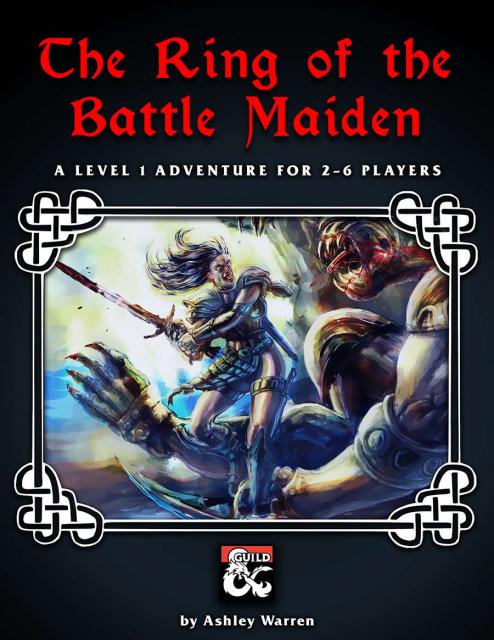 The Ring of the Battle Maiden Cover
The Ring of the Battle Maiden Cover
Ok, so this might take a moment to explain and why this is not a review, but my reaction to the adventure. Yes, I noticed what could be called the "panty shot," the uncovered hip and thighs, and what reminds me of garter belts. Yes, the cover made me nervous about the rest of the content since it’s the first adventure I read from this author.
I sat with those reactions for a moment and then also noticed the abstraction to the art, the amount of muscle, and the fact that her face is determined and fierce. I also went through the rest of the art. While Ashley calls the adventure campy, it doesn’t feel exploitative to me and just seems comfortable and fun.
The cover wasn’t the only piece I enjoyed. In particular, I’d like to call attention to the Kas the Cutthroat.
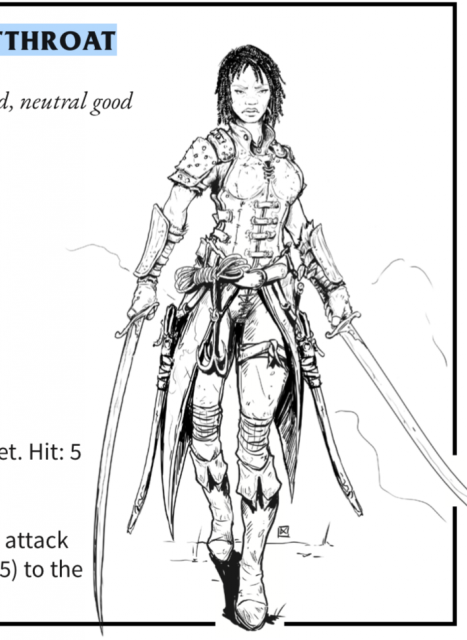 Kas the Cutthroat
Kas the Cutthroat
Finally, sitting back and taking a look at the adventure as a whole (which I get is short and intended to be simple), I love the fact that Daughters can be of any gender but the terminology centers on women and that by using it as an introductory adventure, the players will start out with a strong group of women that they can potentially ally with throughout the Realms.
The only thing I might say that is more critical is that some of the read aloud text is fairly long so DMs might want to consider how they want to handle those. I only bring it up because I get super self-conscious when I speak for too long, especially when it’s due to read aloud text. But that is the smallest of issues and is a matter of opinion and style.
I highly suggest checking out the adventure and keeping it ready to run whenever you want something simple and straightforward for folks to check out. You can find it here (affiliate link).
Aquarium Death Spiral
One of the more obvious crossovers between fishkeeping and tabletop role playing games has to do with the death spiral. While some games embrace the death spiral, I know lots of folks try to avoid it happening.
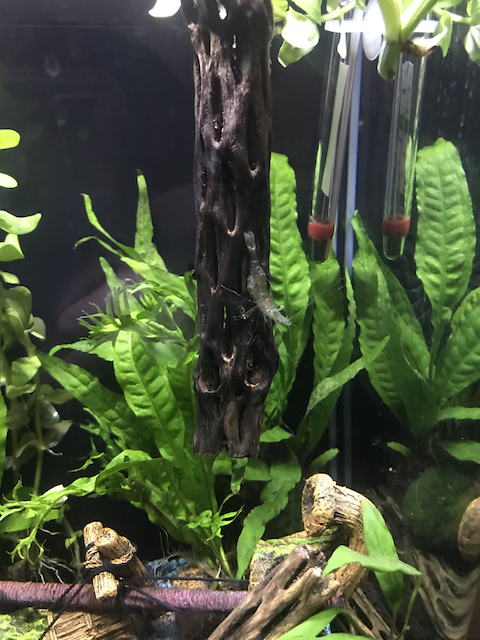 Aquarium - Shrimp
Aquarium - Shrimp
I couldn't find an exact definition anywhere but the way I'm accustomed to the term being used is that when seemingly small events lead one towards an almost inescapable catastrophic conclusion. Small failures can compound on each other and, if not handled well, lead to game play that is unsatisfying and counter to the desires of the folks playing.
With aquariums, the death spiral is quite literal and can be difficult to overcome, especially in smaller tanks. Often, but not always, the cause is an uncontrolled ammonia spike. This could be the result of old age, a sudden removal of a large portion of either of the two beneficial bacteria pools, etc. Suddenly the system has more ammonia or nitrites than it can handle, which then causes one or more livestock to die, which in turn adds to the ammonia, and pretty soon an entire tank can be wiped out.
In other words, tanks, especially small tanks, can be swingy. :)
What's even worse is that attempting to fix the tank can also accelerate the death spiral. While many different species have different levels of various tank parameters that typically are the best for them, they value consistency even more. So if you notice that nitrite levels are higher than desired and decide to do an aggressive water change, the resulting fluctuations can cause more damage than if you had kept them at the undesired levels and worked more slowly to change them.
In thinking through this, I noticed that the suggestions for how to fix the swinginess and the death spiral in aquariums is similar to how folks limited these things in D&D, and that is by attempting to limit as much as possible the impact of any particular change. For aquariums, the suggestion is to start with a larger tank. One dead fish in a 5 gallon tank will have a different impact than a dead fish in a 55 gallon tank. Making smaller incremental changes leads to a more reliable and predictable tank and game.
That said, unlike fish, our lives aren't on the line. There are times when we can embrace the death spiral and other times when it's probably not what we want.
Fishkeeping and Thoughts of D&D
So over the past few months I got sucked into the rabbithole that is known as planted tanks (or planted aquariums) via YouTube and I took the plunge recently to start two small tanks of my own. As I've been working on them, a few things have struck me as being potentially relevant to gaming so I wanted to share some of what I learned here.
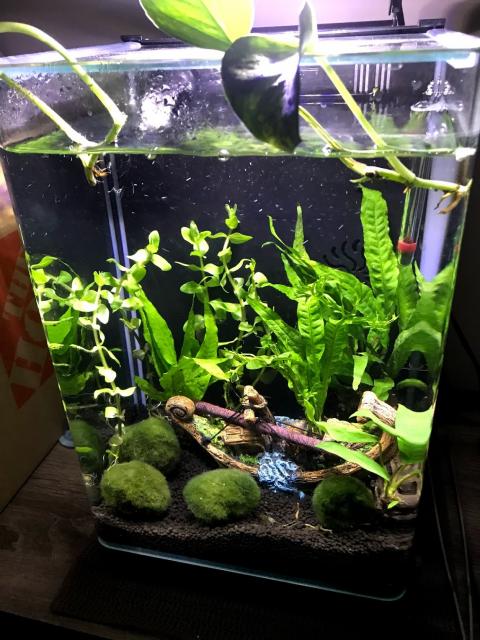
Introduction to Fishkeeping Concepts
One of the neat things about folks who are specifically into planted tanks is that they often are attempting to be world builders. That's because many of them are doing planted tanks as a way to reproduce a bunch of a natural cycle (sometimes in an effort to reduce the upkeep of an aquarium but often because they are super interested in the art and science of it).
To help understand, keeping an aquarium functioning is all about the nitrogen cycle. Animals get fed, they produce waste (ammonia), and ammonia is pretty toxic to the animals. Aquariums typically rely on two different types of bacteria to convert the ammonia to nitrites (which are also toxic) and then nitrites to nitrates (which are less toxic). Water changes often are a way of removing the nitrates from the system, but plants can also remove some of these from the water in addition to providing much needed oxygen for the fish.
In addition to this chemical balance, many attempt to create eye catching displays and sometimes even tell a story through their aquascapes. This in particular made me think of roleplaying games. First is the creation of zones in terms of the water column, usually dividing the vertical area of the tank into thirds. Some fish and other creatures are considered denizens of the bottom, some prefer the middle layer, and others like life at the top.
For plants, we often think in terms of carpeting (plants that cover the substrate like a carpet), foreground (typically shorter or slower growing plants that would be at the front of the tank), mid-ground (plants for the middle of the tank), background (taller and/or fast growing plants), and floating plants (plants that float in the water, especially at the top of the tank). Each of these have their uses and help tell the "story" of the tank.
Another interesting concept is that of the community tank. These are tanks where the species chosen are meant to work well together. So you might have some inhabitants who are meant to be cleaners (shrimp, snails, some types of catfish, etc) and where they might help keep the populations in check since some tank inhabitants can become prolific breeders in the right conditions. This reminds me of quite a few D&D modules including the Caves of Chaos.
Using in an Adventure
There can be a number of reasons why someone or something might be keeping an aquarium in D&D. A wizard or apothecary might find them to be incredibly useful for keeping creatures that produce vital components to spells or potions. A druid might work on creating one to save local creatures during a time of intense climate change. A noble might wish to display their wealth and worldliness by displaying creatures from far away lands.
People have kept fish for thousands of years in outdoor pools or indoors in ceramic vessels not to mention in ponds and the like. For something truly fantastical, imagine the existence of a force field that creates a large area of glass for displaying aquatic life. Perhaps a wizard created one in an underground cavern and stocked it with phosphorescent plants and creatures from the ocean deep.
Or perhaps long ago, a vibrant and verdant land began to turn to desert and thus an effort was made to save the local creatures, moving them into a cavern filled with sunstones that mimicked the passage of the sun. The keepers have all died but their world continues to live on.
What creatures would you stock these aquariums with? How would you tend to the needs of all of the livestock? How would you keep balance? How would the introduction of player characters affect this balance?
Send feedback using the contact form or through twitter, @sarahdarkmagic.
